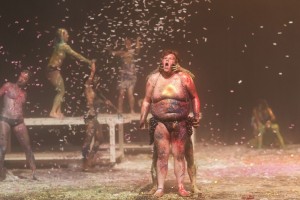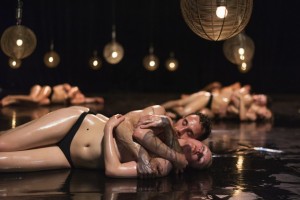A 24 hour performance by Jan Fabre
A conversation with Thouli Misirloglou about “Mount Olympus”
There is probably no better moment than the period we are currently going through for Jan Fabre to present his much discussed performance “Mount Olympus” in the country which gave birth to tragedy, and also where at present a multifaceted crisis is unfolding on a political, social, economic and ideological level. This dynamic artist, who is without doubt one of the most complex artistic figures of the 21st century, accepted the invitation (and challenge) of the Municipality of Thessaloniki and he will be presenting “Mount Olympus” in the context of the 50th Dimitria Festival, his performance being manifested against the backdrop of the real Mt. Olympus.
As the General Co-ordinator of the Dimitria Artistic Programme, Thouli Misirloglou notes, this is “Jan Fabre’s most ambitious project, with all the elements coming together which have made him headline news in international art”. The subversion, the abrogation of the rules, his critical viewpoint on contemporary artistic expression as well as his radical approach to the concepts of materiality and physicality co-exist in “Mount Olympus”.


For 24 hours, the 27 performers will act on the theatre’s stage: they will dance, suffer, sleep, love and dream, coming into conflict with almost all of the narrative rules of the art of theatre. By selecting the passions and the sins of the anti-heroes of the ancient Greek tragedy, Jan Fabre and the Troubleyn Theatre do not attempt to reconstruct the ancient myths through a simple modernization of the drama’s protagonists, but through the complexity of the characters they set up an overwhelming spectacle.
The 24-hour performance was first presented at the Berlin Festspiele in June 2015, receiving rave reviews. The decision of the Festival’s organizers and Fabre himself to present this particular performance in modern Greece is, however, of particular importance. On the one hand it reveals the intention of Dimitria’s artistic committee, which even through the years of the crisis has managed to compose an admirable artistic programme, to even further internationalise the Festival with specific and engaging selections and on the other hand it also embodies a deep symbolic significance.
Thouli Misirloglou mentions that “Medea, Antigone, Prometheus, Oedipus and Electra, dramatic and at the same time elusive figures, will speak in the Greece of 2015 in a language which is floundering, silent, rattling, which hurts and is hurt or becomes a desperate cry”. “The performance of Jan Fabre”, she continues, “a post-dramatic creator who believes in the power of symbolism and performance, brings forth the reality and the discourse of a concrete artistic universe, such as the one that this particular creator-auteur has built”.
“Mount Olympus” – “the catalyst of this year’s Festival” according to the General Co-ordinator of the Dimitria Artistic Programme – utilizes the familiar stories of the protagonists of ancient Greek tragedies, setting out, however, a new mythological world, where all boundaries are indiscernible. Even the spectators themselves lose their natural role of viewing, as the duration of the performance invites them to participate, while the theatrical experience is transformed into an experience with cerebral ramifications. Jan Fabre has studied in depth the manner of presentation of the ancient performances and with “Mount Olympus” he concludes a research of many years on the ritualistic aspect of performance.
“This mythological world, where prevails darkness, lack of understanding, brutal violence and paranoid love, this world will become ours for 24 hours”, adds Thouli Misirloglou.


